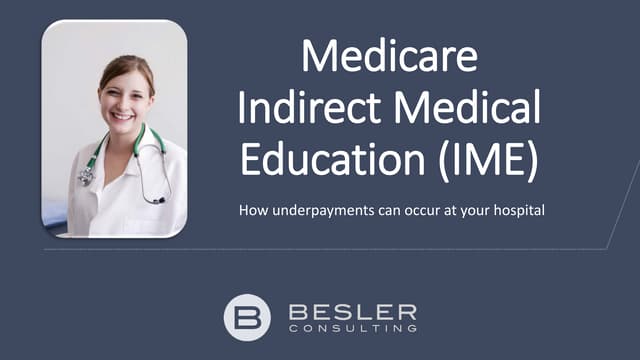
Indirect Medical Education: A Strategic Asset in Healthcare
Indirect medical education (IME) plays a vital role in the United States healthcare system. Although it operates behind the scenes, its impact resonates deeply across teaching hospitals and patient care. Funded mainly through Medicare, IME is a financial support system for hospitals that train medical residents. This article explores its background, structure, and influence on healthcare quality.
What is Indirect Medical Education?
Indirect medical education refers to additional payments made to teaching hospitals by Medicare. These payments support the higher costs associated with training medical residents, including staffing, patient complexity, and technological resources. Unlike Direct Graduate Medical Education (DGME), which funds specific resident salaries and benefits, IME addresses broader, indirect costs.
Historical Background of Indirect Medical Education
IME originated in the 1960s alongside the establishment of Medicare. Recognizing the essential role teaching hospitals play, the U.S. government included IME in its reimbursement strategy. Over the decades, IME policy has evolved to address population health needs and rising medical education costs.
The Role of Medicare in Indirect Medical Education
Medicare remains the primary funder of IME. Each year, billions are allocated to teaching institutions across the nation. The purpose is to incentivize training while maintaining high standards of patient care. By doing so, Medicare supports the development of a skilled, well-distributed physician workforce.
How Teaching Hospitals Benefit from Indirect Medical Education
Teaching hospitals often face higher operational costs. IME funds offset expenses associated with complex patient needs, advanced equipment, and staff required for resident supervision. These hospitals also tend to handle more uninsured or underinsured patients, making IME support essential.
Impact on Patient Care and Medical Training
Patients treated at teaching hospitals often receive superior care due to continuous learning environments. IME enhances these institutions’ capacity to provide innovative treatments and conduct research. Meanwhile, residents gain hands-on experience, preparing them for independent practice.
Common Misconceptions About Indirect Medical Education
One major misconception is that IME funds only benefit residents. In reality, these funds enable systemic improvements in hospital infrastructure and patient outcomes. Another false belief is that IME is unnecessary. However, removing it could compromise both education quality and care standards.
Challenges in Managing Indirect Medical Education Funds
Despite its benefits, IME funding lacks transparency. Allocation methods vary, and there’s ongoing debate about fairness. Hospitals must navigate complex billing systems and compliance protocols to secure funds, which often causes administrative burdens.
How IME Payments Are Calculated
IME payments are determined by a formula considering factors such as the number of residents, the ratio of Medicare inpatient days, and the hospital’s teaching intensity. These variables ensure that funding aligns with training efforts and patient volume.
The Difference Between IME and DGME
While IME covers general costs related to training, DGME focuses on direct educational expenses like resident salaries. Understanding both components is crucial for comprehensive medical education funding.
Indirect Medical Education and Health Equity
IME supports hospitals in underserved areas, increasing healthcare access in rural or low-income regions. It enables the placement of residents in communities that may otherwise lack adequate medical personnel, promoting long-term equity.
Role in Advancing Medical Technology and Research
Teaching hospitals are at the forefront of innovation. IME supports their ability to test and adopt cutting-edge medical technologies. Residents are trained with the latest tools, enhancing future medical practice across the country.
Current Policies and Regulations Surrounding IME
The Centers for Medicare & Medicaid Services (CMS) regulates IME disbursement. Policies are updated regularly to reflect healthcare trends, population needs, and educational priorities. Staying compliant ensures uninterrupted funding.
Future Trends in Indirect Medical Education
The future of IME may involve performance-based funding, encouraging hospitals to demonstrate measurable outcomes. With rising healthcare demands, the focus is shifting toward efficiency, transparency, and technology-driven training.
Recommendations for Policymakers and Institutions
To maximize IME’s potential, policymakers should simplify its structure, increase transparency, and align incentives with quality care. Hospitals should track performance and optimize resource use to justify and enhance funding outcomes.
Conclusion: Why Indirect Medical Education Matters More Than Ever
Indirect medical education is more than just a funding stream—it is the foundation of a resilient healthcare training system. Supporting teaching hospitals, empowering residents, and improving care standards, IME continues to be a cornerstone of medical excellence in the U.S.
FAQs About Indirect Medical Education
1. What is the purpose of indirect medical education funding?
IME funding helps teaching hospitals offset higher costs related to resident training and complex patient care.
2. How is IME different from DGME?
IME supports general institutional costs, while DGME covers direct expenses like salaries and benefits for residents.
3. Who funds indirect medical education?
The federal Medicare program is the main source of IME funding.
4. Are IME payments tied to hospital performance?
Currently, most IME payments are based on formulas, though future policies may introduce performance-based incentives.
5. How do IME payments improve patient care?
By supporting infrastructure, technology, and staffing, IME indirectly enhances the quality of care provided to patients.